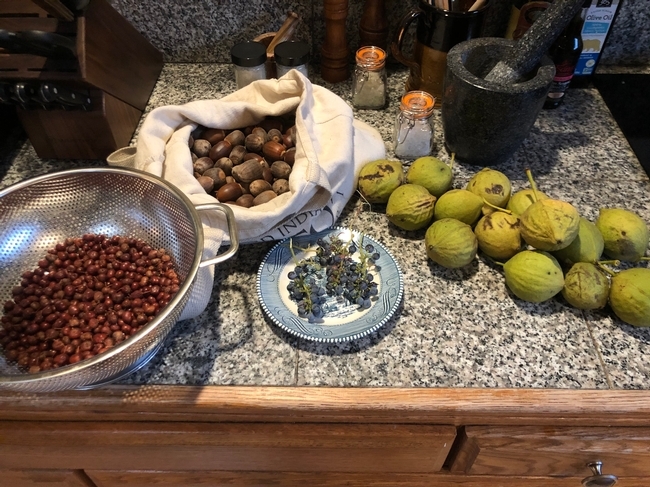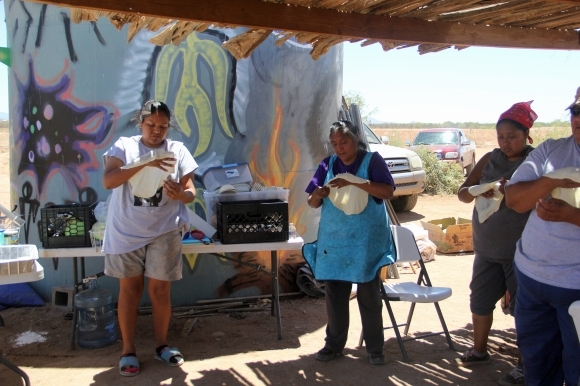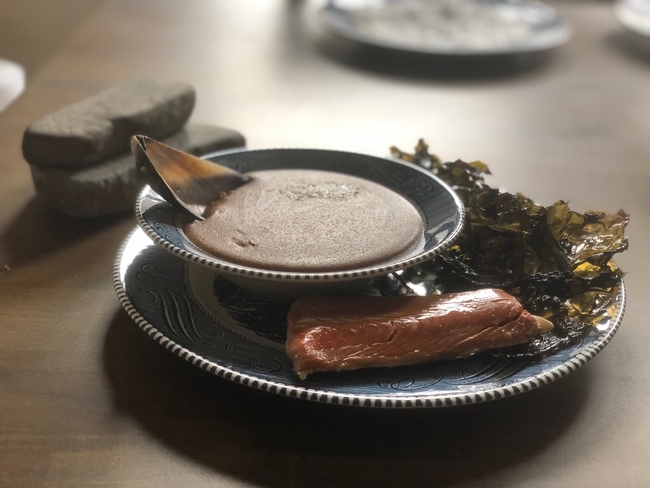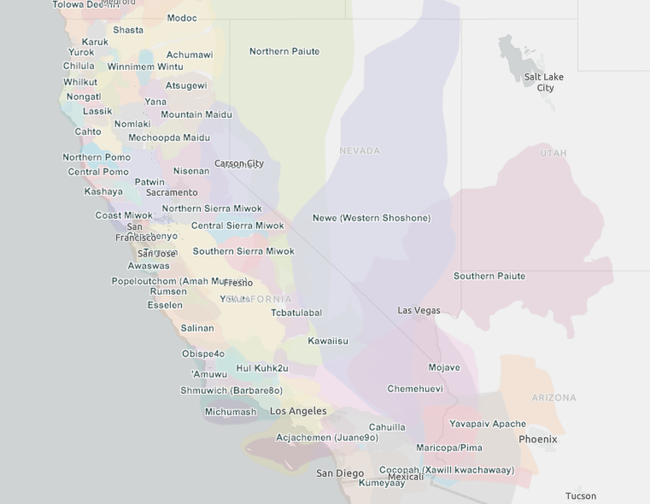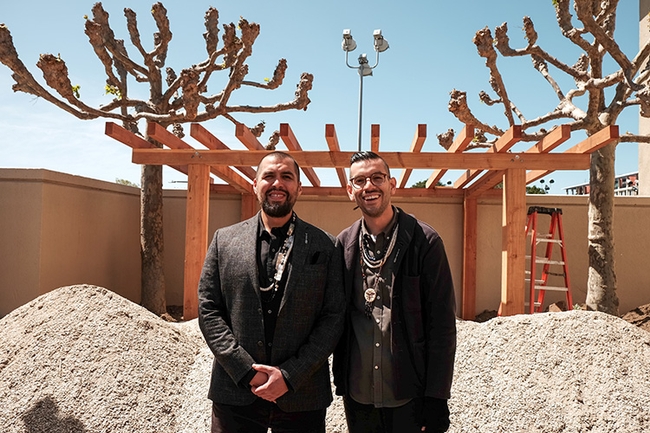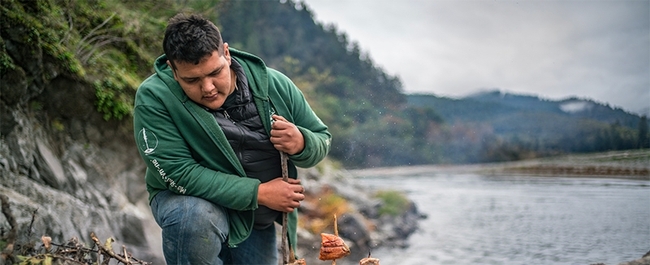Books, videos and songs highlight Native views on ‘thanksgiving’
UC takes some first steps in addressing historical wrongs
Thanksgiving can be a time of celebration, gratitude and sharing. It is also often a time when people assist the most vulnerable in our communities, through donations to food banks, volunteer service and similar acts of compassion. But it is also a time of remembrance and mourning in Native American communities.
The narrative that many people have been taught beginning in elementary school about the First Thanksgiving celebration in the United States is based on historically inaccurate myths that fail to acknowledge the devastation wrought by settler colonialism, including genocide, land theft, forced assimilation and cultural appropriation.
Many Native people refuse to celebrate Thanksgiving; some engage in a day of mourning, protesting the genocide wrought on their ancestors and ongoing oppression. Native scholar Philip Deloria (Standing Rock Sioux) wrote about some elements of this in his contribution to The New Yorker several years ago, but for additional information interested readers could also turn to the essay“Deconstructing the Myths of ‘The First Thanksgiving'” by Judy Dow (Abenaki) and Beverly Slapin.
Educators – in formal and informal settings – play an important role in spreading awareness of the atrocities experienced by Native peoples at the hands of the European settlers. In April of this year, University of California President Michael Drake recognized and acknowledged the historical wrongs endured by Native Americans in announcing the UC's Native American Opportunity Plan, which covers tuition and fees for California students from federally recognized tribes. But the statement fell short of acknowledging the ways in which UC has and continues to benefit as a result of those wrongs.
Free tuition for California Native Americans was one of the recommendations in the 2021 report “The University of California Land Grab: A Legacy of Profit from Indigenous Land,” co-authored by UC Berkeley's Native American Student Development program and the Joseph Myers Center, based on a two-part workshop series held in 2020 and covered recently in the June 2022 issue of UC Berkeley's alumni magazine.
While the new UC tuition and fee remission plan is a big step in the right direction, it excluded the many California Native Americans who are not members of federally recognized tribes. Fortunately, the Federated Indians of Graton Rancheria created a scholarship fund to cover tuition and fees for these students.
Another important step that University of California Agriculture and Natural Resources is taking, in alignment with recommendations from the “Land Grab” report, is the recruitment of three new UC Cooperative Extension academics centering Indigenous communities and perspectives on topics related to farming and food sovereignty, climate resilient disaster planning and policy, and beneficial burning and Indigenous land stewardship.
The focus of these positions acknowledges the importance of strengthening partnerships with Native American communities, uplifting their voices, leadership, concerns and solutions around addressing some of the most pressing environmental and societal challenges facing California communities today. Voices from the Washoe Tribe, for example, were central in the recent UC California Naturalist statewide conference along the north shore of Lake Tahoe.
Native perspectives on thanksgiving
Celebrations of harvest certainly did not originate with settlers and Native Americans sharing a meal in the 17th century. Rather, they have been integral to the fabric of Indigenous existence since time immemorial, as Native communities view “thanksgiving” as a time for honoring the ancestors, which includes the lands, plants and animals that are understood as relations.
In her book, “Braiding Sweetgrass,” Robin Wall Kimmerer describes how the Haudenosaunee people (in the northeastern U.S. and southeastern Canada), recite the Thanksgiving Address, “a river of words as old as the people themselves” known in the Onondaga language as the Words that Come Before All Else, “whenever they gathered…before anything else was done. ”
At its core, the Thanksgiving Address is an expression of gratitude for “the ones who share their gifts with the world,” including the water, the fish, the plant foods and medicines, the animals, the winds, and the sun and the moon and the stars.
Taking a decolonizing approach to Thanksgiving rejects the myths of Thanksgiving and harmful stereotypes about Native peoples that reinforce oppression, and invites opportunities for deepening a collective understanding of Indigenous history, amplifying Native perspectives that highlight the diversity of Indigenous peoples and foodways, and support Native-led food sovereignty and land stewardship initiatives that affirm contemporary presence and self-determination of Native people in 21st century America.
UC Berkeley Professor Peter Nelson (Coast Miwok and tribal citizen of the Federated Indians of Graton Rancheria) offers this helpful insight: “We have plenty of points at which we give thanks for what our non-human relations give us or honor the changing of the seasons and gathering times. The fall in my language, Coast Miwok (Tamal Machchaw), is ‘umpa walli' or ‘acorn time.' Some of these concepts don't exactly translate from English. ‘Thank you,' or ‘ka molis,' means something more like ‘I'm glad/happy.' We express a state of being or how it makes us feel. The same is true of the concept of ‘I'm sorry,' which doesn't exist in our language. We have to contrive something to the effect of ‘my heart is sad' – ‘ka wuskin sawa.' Again, a state of being and there is a sense that you should just express how to fix things if they are out of sorts. Hearing a settler apology isn't enough. Do something about it.”
What can you do?
Below are just a few ideas of how you can learn about the authentic history of Native Americans and center your Thanksgiving messaging around social and environmental justice. Equally important, through these resources, you can learn about contemporary Native American peoples and communities in both urban and rural areas.
Also included are ways to support the growing Indigenous food sovereignty movement among Native Americans to reclaim and restore their food systems through ecological and cultural restoration and self-determination.
Decolonizing the history and meaning of Thanksgiving
- Read the stories of four East Bay residents and their personal family traditions for the fourth Thursday in November: https://www.berkeleyside.org/2022/11/16/celebrate-thanksgiving-respectfully-indigenous-native-people.
- Share these powerful short videos on Thanksgiving word association and Native people describing Thanksgiving that are helpful for understanding the Native American perspective on the holiday.
- View this brief speech by Linda Coombs (Aquinnah Wampanoag), who used to direct the Wampanoag Indigenous Program and Plymouth Plantation, at the site of the presumptive original Thanksgiving meal, for a greater perspective on the myths surrounding the origins of Thanksgiving.
- Also read this speech that Frank James attempted to deliver before the 1970 Pilgrim's Progress parade in Plymouth. His rejection after the organizers heard the content of his speech led to the National Day of Mourning counter-parade that takes place each year.
- This article, “The Thanksgiving Tale We Tell Is a Harmful Lie. As a Native American, I've Found a Better Way to Celebrate the Holiday,” is a helpful resource where “Sioux Chef” Sean Sherman (Oglala Lakota) makes the case for focusing Thanksgiving on values that apply to everybody: togetherness, generosity and gratitude – as well as embracing Indigenous foods, which are centrally featured in Thanksgiving meals including turkey, corn, beans, pumpkins, maple, cranberries, wild rice, etc.
- An excellent compilation of resources for youth and families by Lindsey Passenger Wieck, can be found in “Decolonizing Thanksgiving: A Toolkit for Combatting Racism in Schools,” that includes books, articles and inspirations for lesson plans, several of which are listed below.
- Helpful book suggestions and educational resources for teaching Thanksgiving in a socially responsible way, including lesson plans for all ages, are provided by the Southern Poverty Law Center at https://www.tolerance.org/magazine/teaching-thanksgiving-in-a-socially-responsible-way.
Learn about the Indigenous history of the United States and the Native lands and people where you live
- Read Peter Nelson's “Where Have All the Anthros Gone? The Shift in California Indian Studies from Research “on” to Research “with, for, and by” Indigenous Peoples”: https://anthrosource.onlinelibrary.wiley.com/doi/10.1111/aman.13633.
- Spend some time researching the environmental and cultural history of the lands where you are standing, starting with identifying whose lands you are residing in via this interactive map of Indigenous territories and learning about how you can support them.
- Learn about how the University of California and the other land-grant institutions of higher education were founded upon the expropriation and sale of Indigenous lands that were “granted” to every state under the Morrill Act in this High Country News article and this UC Land-Grab Workshop series. On this interactive map created by UC IGIS at https://arcg.is/1GTiuv, you can identify specific parcels that were “granted” and the Native communities from whom they were taken.
- Read “The University of California Land Grab: A Legacy of Profit from Indigenous Land,” a report based on the proceedings of the 2020 University of California Land Grab forum by Rosalie Zdzienicka Fanshel, Phenocia Bauerle (Apsaálooke), Deborah Lustig and Jennifer Sowerwine. (Executive summary)
- Educate yourself about the history of Indigenous peoples and the American genocide in the United States. Here are some recommended titles:
- Benjamin Madley's “An American Genocide: The United States and the California Indian Catastrophe, 1846-1873”
- “Custer Died for Your Sins” by Vine Deloria (Standing Rock Sioux)
- Roxanne Dunbar Ortiz's “An Indigenous Peoples' History of the United States”
- Dee Brown's classic “Bury My Heart at Wounded Knee”
- Learn about Indigenous ways of knowing and Native Science. Again, here are some recommended titles:
- “Braiding Sweetgrass”by Robin Wall Kimmerer (Citizen Potawatomi)
- “Decolonizing Methodologies: Research and Indigenous Peoples” by Linda Tuhiwai Smith (Maori)
- “Indigenous Methodologies: Characteristics, Conversations and Contexts” by Margaret Kovach (Nêhiyaw and Saulteaux ancestry from Treaty Four, Saskatchewan; enrolled member of Pasqua First Nation)
- “Native Science: Natural Laws of Interdependence” by Gregory Cajete (Santa Clara Pueblo)
- Learn about how Native Americans have managed California's landscape since time immemorial in Kat Anderson's best-selling book “Tending the Wild: Native American Knowledge and the Management of California's Natural Resources”
- Share what you learn with those in their formative years. There are numerous websites with information decolonizing Thanksgiving (only some of which are referenced above), and both “Indigenous Peoples' History of the United States”(Dunbar-Ortiz) and “Braiding Sweetgrass” (Kimmerer) are available in modified versions aimed at young adult readers.
Learn about, support and amplify Native-led food sovereignty and land-stewardship initiatives in California
- Feature Native chefs in your communications such as Vincent Medina (Chochenyo Ohlone) and Louis Trevino (Rumsen Ohlone) of ot?t?oy/Café Ohlone and Crystal Wahpepah (Kickapoo) to honor their Indigenous food heritage; a PBS NewsHour crew recently featured ottoy, a collaboration between Cafe Ohlone and the Phoebe A. Hearst Museum of Anthropology, and the efforts of the museum to change its approach to repatriation of ancestral remains, funerary objects and objects of cultural patrimony.
- Dine at Cafe Ohlone, which is located at UC Berkeley.
- Watch the film “Gather,” featuring Indigenous chefs, scientists and activists around the country working to restore their spiritual, political and cultural identities through food sovereignty, including Samuel Gensaw (Yurok), co-founder of the Ancestral Guard, committed to restoring the foodways of North Coast California.
- Read about Indigenous foodways initiatives through Civil Eats reporting.
- Promote Native food purveyors, and other Native-owned businesses not only in November but year-round, as a way of honoring Native culture and ethical practices. The Intertribal Agriculture Council's American Indian Foods Program showcases American Indian food businesses and their products, many of which are grown following traditions of their ancestors.
- Learn about and support Indigenous-led land stewardship efforts to restore cultural burning practices by the Karuk Tribe, the Amah Mutsun Land Trust and the North Fork Mono Tribe, among others, to enhance healthy relationships with the land and mitigate against catastrophic fires that have devastated California communities and ecosystems.
- Read the First Nations Development Institute's report on California Indigenous land stewards for more information on both urban and rural Indigenous-led stewardship initiatives and Native perspectives across the state, including the Sogorea Te' Land Trust, an urban Indigenous women-led community organization that facilitates the return ofChochenyo andKarkinOhlone lands in the San Francisco Bay Area to Indigenous stewardship.
Honoring Native people and perspectives on Thanksgiving
- In addition to reading, you may consider visiting a local Native American museum or cultural center during some part of the holiday (courtesy of Eve Bratman) – or on December 3 for the upcoming first annual Tribal Museums Day.
- Play the song “Custer Died for your Sins” and other songs of Indigenous resistanceas music during your celebration. For starters, check out Rebel Beat Radio and Indigenous Resistance (courtesy of Eve Bratman).
- Take a moment of silence and remembrance for ancestors and the people whose land you are occupying, before your meal. Set intentions to learn more and take action to support Native people.

